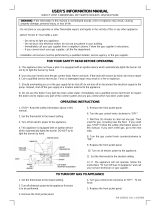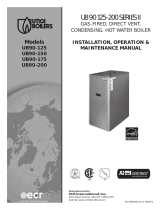
14
BEFORE INSTALLING THE BOILER Continued
PLACING THE BOILER
H. REMOVAL OF EXISTING BOILER FROM
COMMON VENT SYSTEM
When an existing boiler is removed from
a common venting system, the common
venting system is likely to be too large for
proper venting of the appliances remaining
connected to it. At the time of removal of
an existing boiler, the following steps shall
be followed with each appliance remaining
connected to the common venting system
placed in operation, while the other appliances
remaining connected to the common venting
system are not in operation.
1. Seal any unused openings in the common
venting system.
2. Visually inspect the venting system for proper
size and horizontal pitch and determine
there is no blockage. or restrictions,
leakage, corrosion and other deficiencies
which could cause an unsafe condition.
3. Insofar as is practical, close all. building
doors and windows and all doors between
the space in which the appliances remaining
connected to the common venting system
are located and other spaces of the
building. Turn on clothes dryer and any
appliance not connected to the common
venting system. Turn on any exhaust
fans, such as range hoods and bathroom
exhaust, so they will operate at maximum
speed. Do not operate a summer exhaust
fan. Close fire dampers.
4. Place in operation the appliance being
inspected. Follow the lighting instructions.
Adjust thermostat so appliances will
operate continuously.
5. Test for spillage at the draft hood relief opening
after 5 minutes of main burner operation. Use
the flame of a match or candle, or the smoke
from a cigarette, cigar or pipe.
6. After it has been determined that each
appliance remaining connected to the
common venting system properly vents
when tested as outlined above, return
doors, windows, exhaust fans and any
other gas-burning appliance to their
previous condition of use.
7
. Any improper operation of the common
venting system should be corrected so
the installation conforms with the National
Fuel Code, NFPA-54/ANSI -Z223.1-latest
revision, or section 5 of CSA-B 149 for
Canadian standards. When resizing any
portion of the common venting system,
the common venting system should be
resized to approach the minimum size as
determined using the appropriate tables
in part 11 in the National Fuel Gas Code,
NFPA-54/ANSI- Z223.1-latest revision,
or section 5 of CSA-B 149 for Canadian
standards.
The boiler should be placed to provide the most
direct connections to the combustion air, vent and
system piping as possible.
P
lace crated boiler as close to selected location as
possible and uncrate boiler. The uncrated boiler
may be moved into position with an appliance dolly
or 2-wheel hand truck. The dolly or hand truck
should be inserted under the left hand side of the
boiler. It is possible to slide the boiler for a short
distance on a smooth floor or surface.
NOTE: Refer
to manual section “LOCATING
THE BOILER” for required clearances for
servic ing and maintenance.
G. FOUNDATION REQUIREMENTS
Boiler must be placed on level surface.
Boiler is NOT to be installed on carpeting.
NOTE:
1.
If boiler is not level condensate drain lines
will not function properly. Adjustable feet
are located on the boiler to make up for
minor surface irregularities or tilt.
2. Wood frame or blocks may be used to raise
boiler to maintain drain pitch or to be above
external condensate pump reservoir.






















